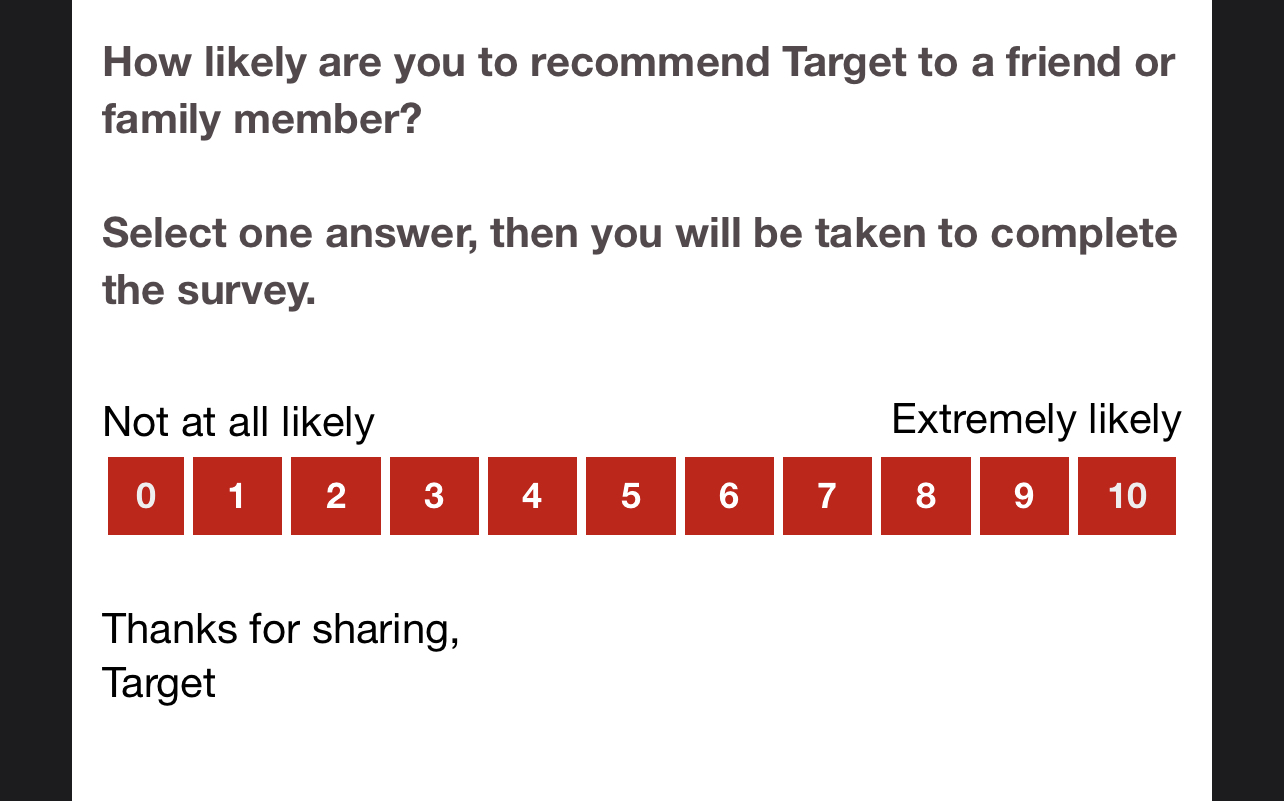-
 6 min. read
6 min. read
-
 Matthew Gibbons
Matthew Gibbons Senior Data & Tech Writer
Senior Data & Tech Writer
- Matthew is a marketing expert focusing on the SEO & martech spaces. He has written over 500 marketing guides and video scripts for the WebFX YouTube channel. When he’s not striving to put out some fresh blog posts and articles, he’s usually fueling his Tolkien obsession or working on miscellaneous creative projects.
What is net promoter score?
Net promoter score is a simple and effective way to measure customer satisfaction and loyalty, by asking one question: “On a scale of 0-10, how likely are you to recommend our company to a friend or colleague?”
Monica recently noticed a sharp decline in customer loyalty. Though her business still makes sales, she has a hard time retaining customers. Finally, she realizes it’s because her customers routinely have a poor experience with her company.
Monica would have figured this out much earlier if she took the time to survey customers (there are plenty of free online survey tools) on their feelings about her company. More specifically, she could have conducted a net promoter score (NPS) survey.
Just like Monica, you can use NPS survey tools to learn how your customers perceive you. But what is net promoter score, and how can you calculate it? Keep reading to find out!
P.S. Want to calculate your NPS right away? Use our free NPS calculator to get your net promoter score in just a few seconds!
What is net promoter score?
Before we get into anything else, let’s address our initial question: What is net promoter score?
Net promoter score (NPS) is a metric that indicates the quality of the average customer’s experience with your business. This metric is tracked by asking a large sample of customers to rate their experience with your company on a scale from 0 to 10.
The total results of this question give you an indication of how people feel about your business, and helps you predict the success of your company going forward.
How to research NPS
We’ve established that the way to research your NPS is to ask the aforementioned question, but in what context? Where and how should you ask that question of your customers?
The answer is twofold, as there are a couple of different ways you can go about it:
Relational programs
The first way to research your NPS is through relational programs. These survey programs are regularly and widely scheduled. With this program, you’ll send out a survey to all your customers (typically via survey emails) on a routine basis, like once a quarter or a year.
Using relational programs will help you get a perspective on your customer base at once, and will help you more easily track the way your NPS changes over time.
Transactional programs
The second method of researching your NPS is to use transactional programs. These programs involve sending out NPS surveys in response to specific customer actions.
For example, if someone makes a purchase on your website, you could include an NPS form in the checkout process. Likewise, if someone makes a phone call to your business, you can end the call by having them respond to an NPS questionnaire via the keypad on their phone.
Questions to include in an NPS form
We’ve already mentioned the most essential element of an NPS survey — namely, the question that asks users to rate their experience with you on a scale from 0 to 10. But what else should an NPS form contain?
These forms shouldn’t be long or complex. That said, here are some additional things to ask users:
- Demographics (age, location, etc.)
- Reason for their rating
- Recommendations on what your business could do better
Each of those will help you get a more comprehensive picture of your results and figure out how to improve them.
Also, note that there are multiple ways to phrase the key question. You could ask users to rate their “experience with [your business],” but you could also ask them to “rate how likely [they] are to recommend [your business] to a friend.” In either case, though, make sure you use a scale of 0 to 10.

How to calculate NPS
Calculating your net promoter score is simple. First, though, you need to know that the scale of 0 to 10 is divided into three sections:
- Promoters (9–10)
- Passives (7–8)
- Detractors (0–6)
Promoters are very satisfied with you, passives are neutral, and detractors are in some way dissatisfied.
To calculate your NPS, subtract the percentage of detractors from the percentage of promoters. The highest possible score is 100 (if all your results are promoters), and the lowest is -100 (if all your results are detractors).
So, let’s say your NPS results for a given period were 30% promoters, 50% passives, and 20% detractors. You would ignore the 50% passives, and then subtract the 20% detractors from the 30% promoters (30-20).
The result would be a score of 10. Anything over zero is good, as it means you have more promoters than detractors. That said, the higher your score goes, the better.
What can you measure with NPS?
While the key question included in NPS surveys is simple, there are actually several ways you can use it. It’s good for more than just measuring overall customer satisfaction. You can also use it to measure people’s views on other aspects of your business.
For example, you could use it for specific products, asking people how likely they are to recommend that product to a friend. You could also use it to rank people’s satisfaction with an interaction with customer service.
In fact, you don’t have to use it exclusively for customers. You can also send NPS forms out to your employees to get feedback from them on how the company is treating them. Of course, make sure those forms are anonymous.
3 quick tips for tracking your net promoter score
Before we wrap up, let’s cover just a few quick tips to keep in mind when conducting NPS surveys:
1. Implement comments from your surveys
Make sure to pay attention to more than just the numbers — your customers’ comments also matter! You won’t have much luck improving your NPS if you don’t pay attention to what users say you could be doing better.
Take their feedback and implement it into your business practices going forward.
2. Segment your audience
Consider segmenting your audience when you gather your NPS results. That’s where the demographics question on your forms comes in handy — you can see how different groups of people and various locations produce different responses.
You can then use that information to help you understand what you could do better.
3. Track changes in your NPS results over time
Make sure you keep up with the way your NPS results change over time. If you see your NPS spike during a particular month or quarter, think about what you may have done that quarter to make your customers happy. Then consider how you can replicate that success.
Likewise, if your score drops, investigate what you did that would cause problems for users, and then take steps to fix it.
Hear from HydroWorx, who saw a 131% increase in organic forms by partnering with WebFXWebFX is a Partner in Driving Results
![]() Watch the Video Testimonial
Watch the Video Testimonial
Get help boosting your net promoter score with WebFX
Looking for help boosting your NPS from professionals you can trust? Look no further than WebFX! We’ve earned over 1,100 testimonials from happy clients, and we’d love to provide you with the same stellar service.
With our review management services, you’ll get help managing your reputation online via reviews and testimonials. That will boost your net promoter score significantly. You’ll also receive a dedicated account representative to keep you updated on everything we do for you.
To get started with us, just call 888-601-5359 or contact us online today!
-
 Matthew is a marketing expert focusing on the SEO & martech spaces. He has written over 500 marketing guides and video scripts for the WebFX YouTube channel. When he’s not striving to put out some fresh blog posts and articles, he’s usually fueling his Tolkien obsession or working on miscellaneous creative projects.
Matthew is a marketing expert focusing on the SEO & martech spaces. He has written over 500 marketing guides and video scripts for the WebFX YouTube channel. When he’s not striving to put out some fresh blog posts and articles, he’s usually fueling his Tolkien obsession or working on miscellaneous creative projects. -

WebFX is a full-service marketing agency with 1,100+ client reviews and a 4.9-star rating on Clutch! Find out how our expert team and revenue-accelerating tech can drive results for you! Learn more
Try our free Marketing Calculator
Craft a tailored online marketing strategy! Utilize our free Internet marketing calculator for a custom plan based on your location, reach, timeframe, and budget.
Plan Your Marketing Budget

Proven Marketing Strategies

Proven Marketing Strategies
Try our free Marketing Calculator
Craft a tailored online marketing strategy! Utilize our free Internet marketing calculator for a custom plan based on your location, reach, timeframe, and budget.
Plan Your Marketing Budget
What to read next






